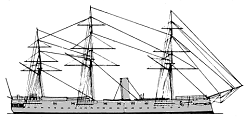
NAVYPEDIA
 Support the project with paypal
Support the project with paypal
Ships
| Name | No | Yard No | Builder | Laid down | Launched | Comp | Fate |
|---|---|---|---|---|---|---|---|
| Druid | Deptford DYd | 1868 | 13.3.1869 | 2.1872 | sold 11.1886 | ||
| Briton | Sheerness DYd | 1868 | 6.11.1869 | 11.1871 | sold 1887 | ||
| Thetis | Devonport DYd | 29.8.1870 | 26.10.1871 | 1.2.1873 | sold 11.1887 |
Technical data
| Displacement normal, t | 1730 |
|---|---|
| Displacement full, t | 1860 |
| Length, m | 67.1 pp |
| Breadth, m | 11.0 |
| Draught, m | 4.95 |
| No of shafts | 1 |
| Machinery | Druid: sails + 1 2-cyl HSE, 4 rectangular boilers Briton, Thetis: sails + 1 2-cyl HC, 6 cylindrical boilers |
| Power, h. p. | Druid: 2272 Briton: 2149 Thetis: 2275 |
| Max speed, kts | Druid, Briton: 13.1 Thetis: 13.4 |
| Fuel, t | coal 255 |
| Endurance, nm(kts) | |
| Armament | Druid, Briton: 2 x 1 - 178/16 MLR Mk III, 8 x 1 - 160/16 64pdr 71cwt MLR Thetis: 14 x 1 - 160/16 64pdr 64cwt MLR Mk III |
| Complement | 220 |
Standard scale images

Thetis 1873
Project history
Designed by Sir Edward Reed. These three ram-bowed corvettes were a continuation of the Eclipse class, the main difference being that they were 2.4m longer and carried a heavier armament. Thetis, being the last of the class, received the revised armament of fourteen 64pdr guns. The general construction was similar to the Eclipse class, with two complete decks, poop and topgallant forecastle, and a light bridge spanning the bulwarks just forward of the telescopic funnel. A feature of the upper deck was a long hammock-box positioned on the centreline between the funnel and the foremast. All three had Griffiths fixed screws with detachable blades and disconnecting tail shafts. They were not good under canvas, the steering being sluggish, and their relatively shallow draught made them poor at keeping the seas. None logged more than 11kts under plain sail. All three were ship-rigged, on the same sail plan as similar ships in the previous class, with a total spread of canvas of 1400m². In the first pair the heaviest guns were slide-mounted, and were sited beneath the poop and the forecastle, resulting in the heaviest end-on fire in any cruising ship, with the exception of Inconstant, and not inferior to contemporary ironclads. When rearmed, Briton and Druid, in common with Thetis, had the 64pdrs slide-mounted on cross skids, the slide centring on a rear pivot bolt-fixed to the midships fore and aft line of the deck. The gun could then be swung round from one side of the ship to the other, a disadvantage being that the arc of swing necessitated a deck clear of cowls, ventilators and other obstructions that might otherwise foul the slide. In 1876-1881 amidship flying bridge was removed, and the compass and engine room telegraph were remounted on the forward end of the poop, the poop serving as the bridge. Bullet-proof sponsons were erected on either beam at the break of the poop. Druid was the last ship to be built in the historic Deptford Dockyard.
Modernizations
1876, Briton; 1882, Druid: were armed with 14 x 1 - 160/16 64pdr 64cwt MLR Mk III
Naval service
No significant events.
 HOME
HOME FIGHTING SHIPS OF THE WORLD
FIGHTING SHIPS OF THE WORLD UNITED KINGDOM
UNITED KINGDOM CRUISERS
CRUISERS BRITON wooden screw corvettes (1871-1873)
BRITON wooden screw corvettes (1871-1873)
